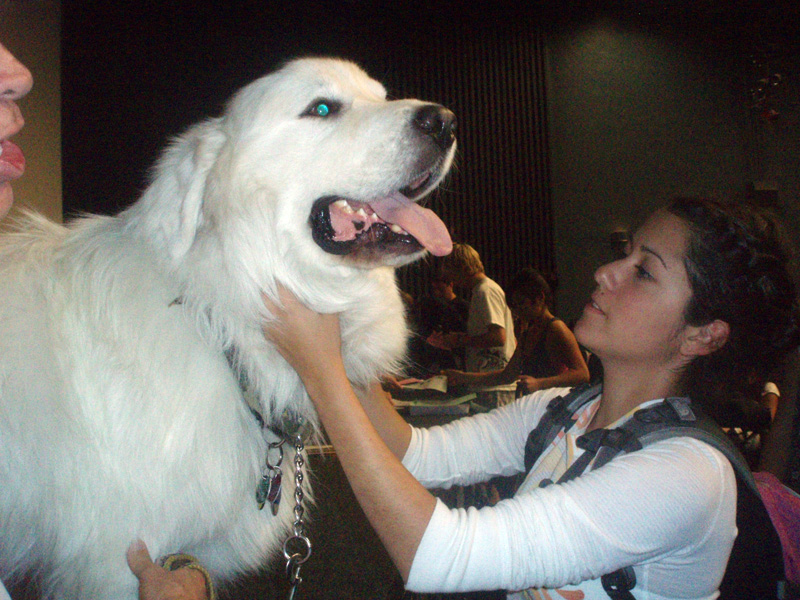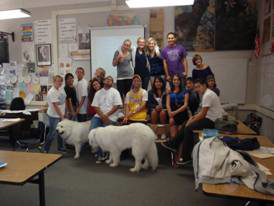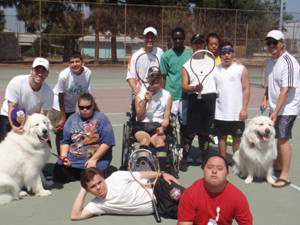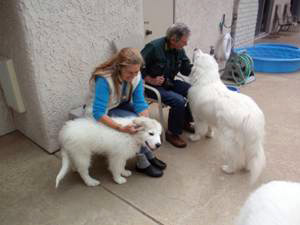By Professor Tommy Dickey
Our rescue dog, Duke, who we now think was part Great Pyrenees (Pyr), passed away at 16 years about 6 years ago. So, after the usual mourning period for a beloved pet, it was time to take in a new four-legged friend. My son David and I decided to go to a dog show in Ventura to check out all the breeds. Seeing my first pure bred Great Pyrenees, it was love at first sight. I was mesmerized and knew I had to have one of these white, furry giants to carry on Duke’s legacy. I met Terrie Strom, queen of the Pyr show world in Southern California, and the rest is kind of history as she has provided me with four Pyrs over the past four years. Sadly, Surfer Girl (aka Bikini and Kiki), a champion show dog, passed away about a year ago. We now have three: Theodore Nansen (Teddy, named for Teddy Roosevelt and Arctic explorer Fridtjof Nansen) who is 3 ½ years old, Mia Solo (only pup in her litter, but mom to 24 Pyrs and also a champion show dog) who is 5 ½, years old, and pup Hot Rod Linkin (4 ½ months and one of Mia’s grandsons) who was born in a chain link fence and is named for the 1950’s rockabilly song ‘Hot Rod Linkin’ by Charlie Ryan and the Timberline Riders. [See the Great Pyrenees Club of America website for more information about the Great Pyrenees breed].
Fridtjof Nansen (Teddy’s middle namesake) is my favorite historical figure, as he was not only one of the greatest explorers of all time but was also an exceptional oceanographer, writer, artist, politician, and humanitarian. I learned about Nansen while visiting the Fram Museum in Oslo many years ago. Fram was Nansen’s ice-reinforced ship that also carried Raold Amundsen to Antarctica, making it still the ship holding the record for voyages furthest north and south. Nansen, like Teddy Roosevelt, won the Nobel Peace Prize and mentored another of the great explorers, Raold Amundsen, whom I have recently been researching for upcoming lectures. Amundsen was first to the South Pole and, some believe, was the first to reach the North Pole (by dirigible with Umberto Nobile and their team).
So, what does all of this have to do with the title? I have always enjoyed teaching and using unconventional links (pardon the Linkin pup pun) to presumably unconnected topics. Enter our Great Pyrenees as my Assistant Professors! I thought it would be fun for students to see our Great Pyrenees and learn a bit about them and other dogs and their importance to geography, exploration, and life at sea. I have brought them to my Geography 3a class (Oceans-Atmosphere) for several years now. I preface the visits with some slides and leading questions about how climate would be affected by increasing the number of Pyrs (I use the increased albedo effect to advantage here! Increased food consumption argument is not emphasized, of course!). I usually bring them in for my Nansen lecture, as Nansen used Siberian huskies to reach the point farthest north (86 14N) in1895. It turns out that dogs were key to not only Nansen’s success, but also to that of Norwegian Raold Amundsen. In addition, I talk about and show pictures of other dogs that have ‘served’ in the U.S. Navy and U.S. Coast Guard, as well as having served in lifesaving ocean rescues. Our Pyrs also sometimes come in for exam days to calm the students’ nerves and to get a few extra pets. I often receive emailed pictures of students’ pets at the end of the quarter. [For more on Nansen and Amundsen, see the website www.opl.ucsb.edu (left hand column of topics).]
Besides using our Pyrs at UCSB, we have also made them a part of the Nordhoff High School (NHS in Ojai) experience. My son, Todd, teaches a variety of subjects, including special education, and coaches tennis at NHS. Our Pyrs walk the school grounds and visit classes, complementing my occasional lectures there on polar explorers. They come to tennis matches and serve as good luck charms. NHS students get some education, whether they know it or not, as they invariably ask lots of questions about the Pyrs, like where they come from (Pyrenees Mountains between Spain and France), what they are used for (guarding livestock), why they are white (to blend in with stock and scare, or worse (!), unwitting predators), and how the students can get one (convince mom and dad that a huge furry white dog would be a really neat new family member!). During this past year, my other son, David, started a Special Olympics tennis team in Pomona. Of course, our Pyrs have joined in these activities as well. In fact, the team and our Pyrs recently appeared in the magazine Inside Tennis. On the Departmental side, Mia, Teddy, and Linkin recently enjoyed a visit from Ray Smith (former Geography Department Chair) and his wife Dominique in Ojai.
So, I have enjoyed using lots of ways of educating students. The most fun for me is to combine a variety of topics and interests with students who are having a lot of fun and unknowingly learning when they least expect it – thanks to big, fluffy Great Pyrenees – Assistant Professors of Geography!








